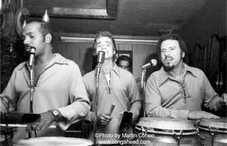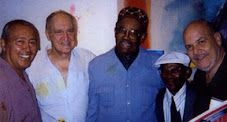
We were dancing the conga on the roof of the Semiramis Hotel in Cairo in 1958, when suddenly all hell broke loose. The Egyptians began shooting off fireworks celebrating the British evacuation of the Sudan. Cheers and laughter greeted explosions until sparks, smoke and flames began to fall at our feet. The band kept playing and the drummers accented each burst as we began to hop and leap with every dangerous blast, like rabbits. You could say the place was really jumping that night.
More peaceful and relaxed moments on the dance floor were spent at the Rainbow Room where society behaved properly, unaware that they were dancing on turf owned by the Mafia management of that time. In Miami Beach at the famous Beachcomber Club, I asked a young lady to dance after requesting permission from the two gentlemen she was seated with at ringside. Little did I know that I was dancing with Virginia Hill and that the two gentlemen were Bugsy Siegel and Meyer Lansky. When she told me her name, I was careful to dance well “apart” during the slow sexy number. Speaking of dancing apart—as disco dancing prefers—it was in Singapore in the fairgrounds that I first witnessed hundreds of young couples artfully dancing without touching. It required some skill and restraint….
New York’s Havana Madrid, with an entrance down a few steps, featured a small bar seating six, overlooking a truly small dance floor that was raised when the floorshow was to begin. The patrons, so eager to dance, convinced the management to leave the dance floor raised rather than waste the time it took to retract it back under the bandstand again. It was at the Havana Madrid that I saw Rene and Estela—he, performing with a glass of water on his head and one balanced at the end of his extended foot as he did the tornillo without spilling a drop. He also performed a somersault, picking up a handkerchief off the dance floor with his teeth. At the Park Plaza on 110th and Fifth Avenue in 1938, Rene had made me get up from my chair so that Estela could teach me to one/two/three/pause, when I didn’t even know how to foxtrot. What I learned on that dance floor that night served me for a lifetime.
Like true fanatics, we ran from La Conga around the corner to the Havana Madrid and back, not even ordering a drink, in order to keep dancing while each of the clubs’ respective bands took their breaks. We might be hearing the same songs in either club. It was almost like not missing a step. Since the clubs were building up their businesses, the managements didn’t stop good rumberos from getting on the floor, even though they weren’t paying customers.
At Fe Fe’s Monte Carlo on the east side, where I seem to recall Enric Madriguera’s upscale café society orchestra playing, I had the nerve to walk in cold with less than a dollar on me, since patrons would invite rumba dancers and teachers to join them. That scene ended abruptly for me when, at one matinee, an inebriated Tommy Manville, the asbestos millionaire, loudly objected to my rumbaing with his young blonde companion.
At the Waldorf-Astoria’s Empire Room in 1943, Xavier Cugat presented Miguelito Valdez singing “Babalu” from behind a curtain. By doing so, Miguelito had just broken down the strict hotel policy of “no person of color.” When he emerged onto the floor, with the slowly brightening spotlight on him, his perspiring rendition of a truly astounding number served to make musical and racial history. I got on the dance floor doing a wild rumba with my partner. The management asked me to leave the floor even though I was dancing, and wearing a U.S. Army uniform at a time when soldiers could take liberties.
Today Beacon, New York, has a very large Latino community that’s mostly Central American, but back in ’38, the gringo audience at the Beacon Theater had never seen the rumba, tango, samba or merengue. (The routines we did were set by the Davalo’s Dance Studio upstairs on Broadway and 48th.) This was most fortunate, that is, because the sold-out crowd did not recognize that we, three couples, were not performing correctly since one partner, when the band began, was still searching for his jacket in our dressing room. This meant the routines went on with three girls and two men—which was of course chaotic! The fact was that when he finally appeared, no one in the audience seemed to notice anything had been amiss.
Dance studios in Miami Beach hotels were unknown until the rumba and conga craze began in 1940. From that time on, all the mushrooming new hotels lining Collins Avenue had to provide for a studio, usually just off the lobby, that served to add a note of “tumult.” The elevated stage that was also the dance floor at the new Carousel Club on 20th and Collins Avenue was so large that although we were not three but four couples doing Latin, we still couldn’t fill the stage. The American all-girl band was led by Anna Ray Hutton. Other clubs, like the Five O’Clock (drinks on the house at five), managed very well with just three couples, and the small Club Bali in Miami, a clandestine gambling joint, hardly held three. The big song was “Tonight We Love.”
Speaking of tumult—a “Jewish” idiomatic expression meaning gaiety—we taught on the polished dance floors of Tony and Lucille Colon’s dance studio at Grossinger’s in the Catskills in 1947. We would also hop over to the rival Concord Hotel to dance the new Perez Prado mambo to the great Curbelo Orchestra. Curbelo also played at the Embassy Club on 57th Street, and at La Martinique, 57 West 57th Street (owned by Dario and his brother), where we danced on the crowded Saturday “Rhumba Matinees” in innovative air-conditioned comfort.
There was no air-conditioning at the Teatro Municipal in Rio in 1952, where we joined hundreds of high Carioca society perspiring—not in the Carnival costumes that, because of Rio’s exhausting night temperatures are the scantiest to be found anywhere, but in strict formal wear. At one point, when all the house lights were extinguished, hundreds of sparkling diamonds flashed at us as the huge spotlights swept back and forth over the gigantic dance floor. I imagine that one does not even experience that at a Hollywood Oscar night or even on the celebrity Mediterranée red carpet in Cannes. When I close my eyes, I can still see their mirrored brilliance.
The most enormous dance floors were those in Havana at the Palacio Asturias and Palacio Gallego. Since dancing is as much a part of Cuban life as breathing, it is clear why the floors were not only so spacious, but located not on one but on two floors of each building, with one floor for the more conservative dancers. Much simpler, in a much poorer country, we danced in an open field under strings of Christmas lights during Panama’s Carnival. Dancing in total darkness on the sandy beach in Saint Martin was cool, followed by a plunge in the surf to continue embracing in the water.
Many drug stores in the fifties had soda fountains. The one under the Palladium’s dance floor risked flakes of paint and plaster falling down on customers. To enter the Palladium, you climbed two flights, stopping to pay your dollar admission on the first floor. There was Cuban Night or Puerto Rican Night until it became everyone’s night. Jimmy La Vaca’s drums were set up next to a two-story iron staircase exit that he told me someone was thrown down. The universal exhilaration came at you from the combined sound and scene (whereas the unwholesome melee years later at Studio 54 was basically artificially drug-induced).
These too well-lit barn-like dance halls lacked the romantic intimacy and almost familial environment of smaller spots like the Park Plaza, that one could label a neighborhood institution. The tiny ticket window at the entrance resembled today’s barricaded bodega cashiers. Primitive toilet facilities at the Park Plaza featured a very long communal trough with constantly running water, visible to the ladies who passed by on their way to the ladies’ room. Bells sounded for rare disturbances. (In Washington Heights, at the Audubon Ballroom, the venue of Malcom X’s assassination, Anatole Broyard and I witnessed a senseless murder while people kept dancing. I called it a triumph of life over death.) Chairs lining the walls, separating women and men, were thrown onto the dance floor as mock protest when the band appeared ready to take a break. This playful demonstration was inspired by the popular cowboy movies of the 1930s.
The dancehall was safer than West 114th St. called the most dangerous street in Harlem, before it was torn down for a housing unit. Between Lenox Avenue and Fifth Avenue, West 116th was the main street, along with 125th Street. Fifth Avenue was a two-way street, ending downtown inside Washington Square Park, for the wonderful wicker seated double-decker buses.
The sloppy bar with its wet floor and beer bottles underfoot didn’t speak well for the Palladium. Nell’s, on West 14th Street, had an awkward floor, causing entrants to pass through dancers on their way to tables. The Corso in Yorkville, 205 East 86th Street, upstairs and “open ’til 6 a.m.”, had great music but a bad reputation until standards were lowered, as would be the case at Studio 54.
When the building was sold and the Palladium was gone, a second Palladium was attempted on East 14th Street in the 1960s but its location defeated it. The venerable Roseland continues providing pleasure, having offered names like Hector Lavoe, Milly y Los Vecinos, Orchestra La Sensual, Angel Canales, Machito, Santiago Ceron and Yomo Toro, Davilita, along with veterans like bassist Leo Fleming, conguero Candido, and timbalero Manny Oquendo.
Going back to the 1930s, we would memorialize the Park Placa (now La Iglesia Cristiana Pentacostal) that we can call the progenitor, with our heads bowed in recognition of the past and present genius that is alive still as it was performed by, for instance, Doroteo Santiago, Pagani's Happy Boys, Panchito Rizet, etc. Que dios los bendigan todos.
It wasn’t Madison Square Garden, the New Yorker Music Center or at the Audubon Ballroom where we personally found our most supreme dance experience. It wasn’t El Liborio, Tropicana or even in the bateys of Havana. It wasn’t at the Casino Intrnational in Port au Prince, the Silver Slipper in Nassau, the Scheherazade in Paris.
It was under a canopy riddled with billions of diamonds, where a carpet of low hanging stars danced along with us. Out on deck in the darkness, off the coast of Bahia while crossing the equator under the Southern Cross, where we frolicked with gravity, rolling with the ocean, rocked in the cradle of the ship while land was a thousand fathoms beneath our feet. We were dancing on the ocean.
 There was no dancing in the streets when the Instrument of Surrender was being signed aboard the USS Missouri in
There was no dancing in the streets when the Instrument of Surrender was being signed aboard the USS Missouri in 













